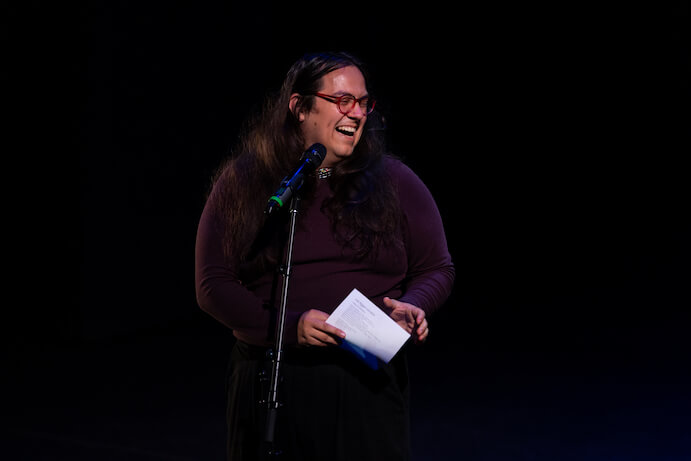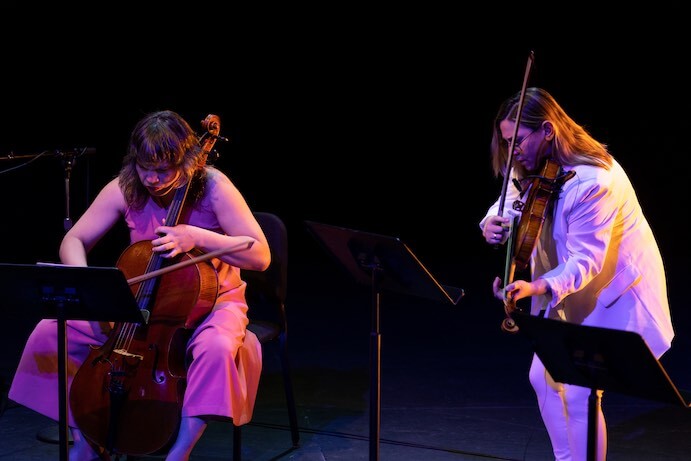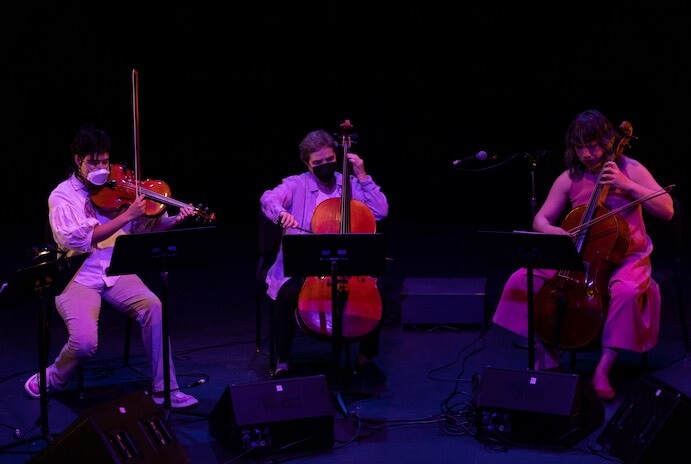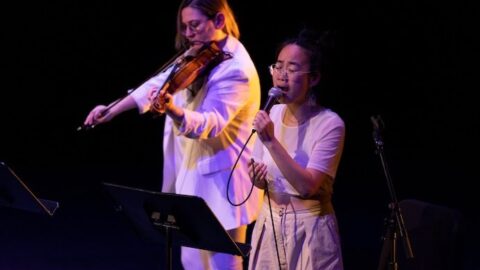In a concert featuring music by five composers, one would normally expect to hear contrasting styles and aesthetics to differentiate one creator from another. That wasn’t the case at REDCAT, in downtown Los Angeles, on June 3. In “Music for Transitions,” composer-curator inti figgis-vizueta sought to create an “unbroken dialogue” between her friends and collaborators by merging their music into a continuous 70-minute program. Rather than emphasizing what makes each composer unique, the program drew throughlines between their works, revealing shared obsessions, convergent discoveries, and similar methods of execution. In a society that valorizes individualism and encourages competition, this purposeful blending of creative voices felt like a revolutionary choice.
Interspersed between full works by figgis-vizueta, Caroline Shaw, Andrew Yee, Nico Muhly, and Leilehua Lanzilotti were “mosaics” of string quartet fragments composed by figgis-vizueta over the past several years. All the transitions were seamless, making it difficult to tell where one piece ended and the next began; I enjoyed this continuity but would have liked some non-intrusive signals to indicate where we were in the program.

The performers — cellist Yee, violist Nadia Sirota, vocalist Mingjia Chen, and the CalArts String Quartet — put on a tastefully amplified and enrapturing show. From meditative drones and whistle tones to violent strokes and percussive strikes, their playing was dynamic and raw. Chen’s voice was light and lovely, at times evoking Fiona Apple or Björk, while also sounding refreshingly uncategorizable as she sang the names of trees (Yee’s Trees of Greenwood) with a shapeshifting tone and delicate ornamentation.
I was excited to finally see Sirota live for the first time, and she did not disappoint. Standing and leading cues throughout the show, she duetted with Yee and carried many big solos, including Drones & Viola, written for her by Muhly. Sirota plays with an introspective confidence that shone in this viola-forward program — among the highlights of her performance were precise octave double-stops, tempestuous tremolos, and the myriad colors of her pizzicato.

Yee is a rare performer whose powerful tone and unflinching expressivity commanded the audience’s attention. I swear I heard more than one gasp when Yee started playing. Instead of using an endpin to anchor the cello to the floor, she plays with the cello cradled between her legs, like a viola da gamba, her feet turned out like a ballet dancer mid-plié. At several points during the show, she combined cello playing with singing, maintaining a steady vocal pitch while rapidly bouncing through arpeggios.
Yee was part of figgis-vizueta’s vision from the start; before it became an evening-length show, Music for Transitions was a piece that Yee commissioned from figgis-vizueta. Their multi-year collaboration resulted in a cello quartet (with Yee overdubbing all the parts) and an accompanying music video that assembles four separate videos of the cellist into an “exquisite corpse”-like frame; Yee’s head from one take is placed on top of her hands from another take, which sit above her legs from the third take, and so forth, creating a mesmerizing, moving mosaic of disjointed yet strangely coherent body parts.

Given the project’s history, I expected video to play a big role on Saturday; it did not. Save for some subtle lighting changes, the only visual elements onstage were the musicians, which made it easy for the audience to focus on the physicality of their performance. This pivot proved an excellent move. According to the program notes, figgis-vizueta composed and curated the program to showcase the “improvisatory spirit” of “exploration-based performance practices,” and for that kind of play, the physical body is important to acknowledge.
It’s no stunning coincidence that these works by Shaw, Muhly, Lanzilotti, Yee, and figgis-vizueta all contain some combination of overtone noodling, zippy glissandos, scratchy bow dragging, snappy plucking, droning, and pulsing four-string arpeggiations. Unlike textbook counterpoint, these compositional techniques are rooted in sensory experiences – in the ways that players idiomatically interact with their instruments. When a child picks up a violin for the first time, they don’t play scales and arpeggios; they slide and wiggle their fingers around, make unpredictable noises, and occasionally discover things that vibrate in pleasing ways. And even as professional musicians, these embodied ways of making sound can feel thrilling to excavate.
I CARE IF YOU LISTEN is an editorially-independent program of the American Composers Forum, and is made possible thanks to generous donor and institutional support. Opinions expressed are solely those of the author and may not represent the views of ICIYL or ACF.
You can support the work of ICIYL with a tax-deductible gift to ACF. For more on ACF, visit the “At ACF” section or composersforum.org.
























